EDITOR'S NOTE:
Oh my God no, not the resolution problem again, please no! The Cliffhanger - Edward Randy's internal resolution is 256 x 240 which is more square than 4:3. This is less egregious than Capcom's absolutely depraved 384 x 224 resolution but it's still a little squarer than would actually appear on real hardware, given that most arcade cabinets would have a standard 4:3 CRT monitor. So, we've taken the liberty of stretching the screenshots to 320 x 240 to more closely replicate what the game would look like on a real arcade cabinet. You have no idea how many articles we're gonna have to go back through to make this change to though... And by 'we' I mean 'me', just me, I'm the poor sod who has to do all that crap. Sigh.
Also, this review is based on both the Japanese ver. 3 and World ver. 2 arcade revisions of the game, as these seem to be pretty much the same game, with no obvious rebalancing or alterations. This is important because World ver. 3 changes the order of the stages significantly, but we'll get to that later, don't you worry.
If exciting arcade gamesoft has a name... It must be Data East.
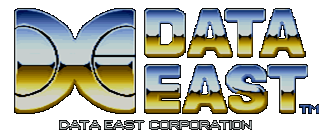
It's no secret that I love Data East. If you've read my articles about Bloody Wolf and Fighter's History Dynamite, you'd know this. Even when I don't like a Data East game, like Bega's Battle, I still believe in their power to make baffling, weird and exciting games. Their games make a lot more sense when you read this 2004 roundtable interview with four anonymous Data East employees which makes the company sound like chaos incarnate. Crack-of-dawn drinking parties, having their yearly bonuses for 1991 paid for almost entirely by Captain America and the Avengers, creating a touch-screen with no idea what to do with it... One of the interviewees describes the company's output as "mirror images of the designers' tastes, which made them feel edgy and unusual" and that seems pretty accurate, as does one comment from the interviewer, "the line between a work of genius and something crazy was razor thin". If you want more insight into the company, you can take a look at this 2002 roundtable interview too, definitely worth a read.
The 2004 interview also talks quite extensively about today's game, The Cliffhanger - Edward Randy, helping to explain the development process and why the game is the way it is. Fitting in with the theme of their games being reflections of what the designers enjoyed, one person explains that, "it was originally developed as an experimental title. The initial planning staff stuffed the game with all their favourite things" and another elaborates that, "It took a huge amount of time to develop, in any event. Cramming the game with everything we wanted also meant that we created a lot of trouble for ourselves" which, when you see the final product, definitely sounds about right. However, they also mention that this game, alongside Desert Assault / Thunder Zone and Mutant Fighter / Death Brade, wasn't a huge hit for Data East (hence why Captain America was a big deal for them, it got the company out of a tight spot). That's particularly unfortunate for Edward Randy because, for me, it is the definitive Data East arcade game, as while it's perhaps not as weird or outlandish as something like Trio the Punch: Never Forget Me... or even Karnov, its adventurous spirit and unwillingness to slow down even for a millisecond, even to the game's detriment in some parts, makes it the most Data East game in my estimation. Now, let's say it along with Edward- OK, here they come!!
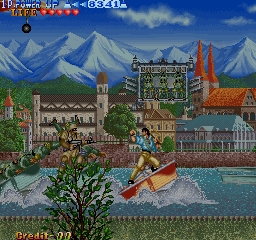
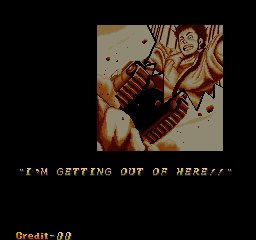
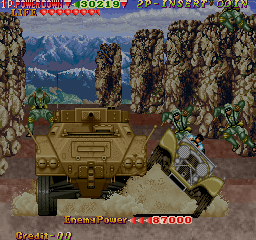
Released in January 1991 according to アーケードTVゲームリスト 国内•海外編 (1971-2005) (ISBN: 978-4990251215) despite the 1990 copyright on the title screen, the flyer promises that "100 adventures await you!" in Japanese (and "A legendary adventure" in English, which makes me think of "The Return of the Great Adventure" used on the poster for the 1982 rerelease of Raiders of the Lost Ark in cinemas- here's the original artwork for the flyer which is yes, very Indiana Jones-esque) and, well, Data East did not disappoint. Set in the mysterious timezone of September 14th, 193X (presumably around the same time a certain Henry Jones Jr. was making things up as he went along to find the Ark of the Covenant), our hero Edward Randy has a date with his girlfriend Jennifer today... But his plans get thrown out the window (literally) when Charlotte bursts into his house, chased by soldiers! After a dramatic escape via Ed's boat where Charlotte's life is exchanged for a mysterious prism, she explains that the soldiers are under the command of the military leader Dark Ogre, and the prism was created by her grandfather who didn't realise it was going to be used to power a solar cannon powerful enough to vaporise anything! Edward then sets off to get the prism back and stop Dark Ogre from taking over the world, with nothing but a whip in his hand (his favourite, called 'Cliffhanger'- see, that's where the title comes from!) and courage in his heart. Fight on, Ed! [Who, me? - Ed] Weirdly, the game actually begins near the end of the story, a battle in front of a waterfall with a gigantic robotic abomination followed by a dramatic skirmish in the sky amidst exploding biplanes, ending seconds before the final boss shows up to turn back the clock to earlier that day and explain how Edward got into this wild situation. That's movie-like storytelling for ya!
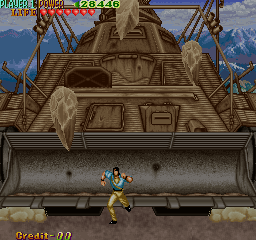
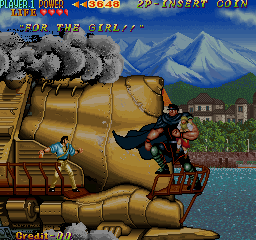
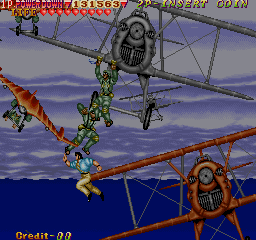
There's a couple of moving parts to talk about here, so let's start with the controls. For a platformer with just a control stick and two buttons there's a surprising variety of moves, but first-time players are definitely going to be flummoxed a little- you'll try to jump to avoid something but end up doing a slide that crashes you headlong into danger. This isn't because the jump button doesn't work though, it's because while there's a little bit of context sensitivity involved, your actions are mostly dependent on which direction you're holding at the time. Your standard attack is a whip that can be aimed in most of the cardinal directions (with downward directions available during a jump) and punches and kicks when close to an enemy (plus holding Down during a jump will kick downwards!) but you also have a ton of mobility options including jumping (hold any upward direction to jump, hold Up to jump higher and grab platforms), running (hold Up-Left or Up-Right) sliding (press Jump with the stick in neutral or any downward direction for a slide, hold Down to grab the platform below you) and his strongest move, the whip swing (hook your whip onto something and swing around). That's not even mentioning the stage where Ed gets to drive a car with moves like slamming the car door into enemies, doing a wheelie and swerving to hit baddies with the back end! This reliance on holding directions certainly makes the game easier to play on a proper arcade stick as opposed to a pad, so better break out the Real Arcade Pro for this one. On the one hand, this means Ed can theoretically really move around the screen with greater aplomb than other platformer heroes of the time, but it's not exactly intuitive for a new player, which is a bit of a big problem for an arcade game, seeing as it needs to be as immediately graspable as possible. In particular, the close-range attack that replaces your whip can often lead to you being unable to hit enemies until you move out of range which is quite annoying at times! There's also a slight stiffness to movement, but with a bit of practice you can adjust to it, and once you get a grip on the complete chaos surrounding you, you can get to where you want to go in quite a few different ways.
Still, the mobility you have available feels like an appropriate choice when you consider how the levels are put together here, and they mesh fairly well. This level structure is one of the more unique elements of the game, as while it's fairly short with seven stages (and the last one is just the final boss fight), it doesn't have the traditional left-to-right setup of the genre. Instead, you might describe this as a single-screen platformer with mild auto-scroller elements, where you're not really moving through areas but they're moving around you, with Edward moving from vehicle to vehicle or foothold to foothold while enemies pile in from every direction, and I do mean pile in. The first two stages, for instance, have Edward jumping from biplane to biplane (the biplanes are usually exploding) and the third stage takes place entirely on a speeding motorboat, with the perspective sometimes switching from the side of the boat to the front (with a pretty impressive bit of visual trickery making that happen). Ed's mobility makes a lot more sense in this kind of environment, where you want to zip to another part of the stage fairly quickly, and while it's a bit clunky at first, you do get used to it. This kind of stage structure also fits well with his most powerful move, the whip swing. This sort-of breaks the game a little as Ed is completely invincible during it, it covers a huge part of the screen and you can change your swinging direction and even go completely 360 a few times before you're forced off, with the compromise being that you have to actually hook on to something, and that's not always an easy option or one at all. Sometimes you have to use your imagination a little- in the first few stages for instance, you can obviously hook your whip onto the wings of the biplanes but also the propeller which is a lot easier to hit in the middle of a fight!
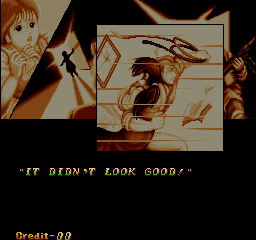
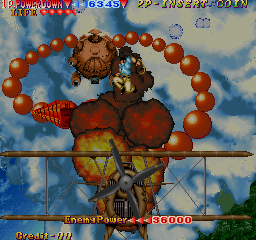
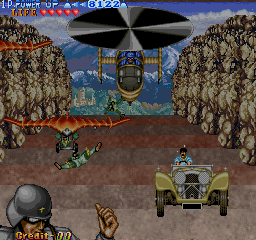
What was that about enemies piling in, though? This is one of the more well-known things about this game, it is complete chaos. From the moment you coin up, you are going to be constantly surrounded by enemies and threats at pretty much all times, and considering the single-screen nature of the game, things get cramped fast. Ranging from standard unarmed soldiers to gun-toting grunts to every kind of vehicle you'd expect from the time frame and even some heavily-armoured robot-like enemies that look like they walked in from Crude Buster, most of the popcorn enemies can be dispatched with a single whip but others are hardier and their relentless march into the skirmish means you never get a second to rest or even take stock of when you're hit (you just flash red except for PINCH! hits, more on those later). The environment itself, as it's constantly shifting and changing, is also a big threat, mostly in the form of falling off the screen or into the water (luckily this is not an instant-death, you just get catapulted back into the fighting scene) but also things like rocks and debris falling from above occasionally appear. This makes the game exciting and dynamic but also somewhat difficult to keep up with, especially since sometimes safe ground is actually covered by foreground objects like crashing ocean waves, and that's why the whip swing is absolutely vital for survival, otherwise Ed doesn't really have enough speed with his whip to keep up with things. The mobility helps too, mind, but this game goes at a breakneck speed and, if Ed was a one-hit-death kind of guy, it's be completely impossible to get by unscathed.
Luckily, he's not! This focus on constantly being barraged by enemies dovetails somewhat with the other big mechanic of the game and one of its more confusing elements, the health system. There is a life meter, sure, but you absolutely do not want to pay any attention to it- instead, it's your score, or POWER, you need to look at. Defeating enemies raises your power level and getting hit decreases it, and should it ever reach zero, you'll die (and you only get one life per credit, although as seen on The Cutting Room Floor, there appears to be some unused life icons). I like most of the way this works, as it gives the game something of an ebb and flow as you can claw your way back from dangerous situations, similar to how a down-on-their-luck action movie hero slowly gains an advantage over the enemies and obstacles in their way. Unfortunately, the strange way this system works isn't communicated that well to the player for a few reasons. First, you start with 3000 points and, as you progress through the game, the power points steadily get larger and larger to an absurd degree, but enemies also hit much harder, so it's hard to get comfy on figuring out just how much damage things are going to do to you (the bosses also get a power-creep, leading to an absolutely ridiculous amount of life for the final boss, but luckily Ed can cut through it with practice). More importantly though, the score takes its time to roll down when you take damage and if the damage you took happens to take you down past zero, you'll instantly die. This is why it sometimes feels like the game kills you for no real reason- it's because the game doesn't play by EarthBound rules, it won't wait patiently to kill you when the damage rolls down to zero, it'll kill you the second you take damage huge enough to take you down to zero, rolling down be damned. The game tries to account for this by displaying PINCH! in huge letters if you take a lot of damage at once (and also sending Ed reeling), acting as a warning to be careful, but this system, combined with the way that the PINCH! hits are the only real feedback you get for taking damage and how the enemy attacks are constant and unending, does make it often feel a bit unpredictable when you're going to take a fatal hit, and that doesn't feel great.
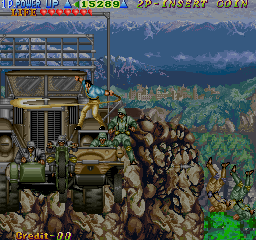
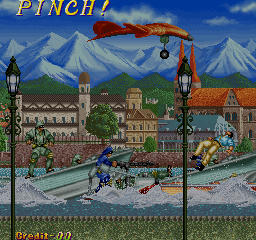
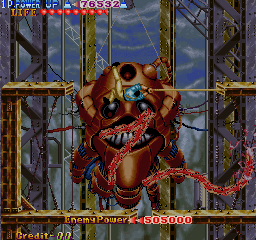
... So, if you've been on this website for more than five minutes (I'm so sorry), you might be expecting me to give this one something like a 2 or a 3 out of 5 because I've listed a fair number of criticisms here. I tend to get in the weeds a little on this little hovel of mine, it's a habit but I like seeing what makes a game tick, what makes me like it and what doesn't, so I tend to be a little critical and maybe a tad harsh. However... In spite of these issues, I love this game and I won't lie, I might be a wee bit biased in its favour, but that's OK, right? I mean, is Edward Randy a bit messy, a bit scrappy? Yes. Oh God, yes. Those are Data East qualities, though- their works are often a little off-kilter, a little strange, a little chaotic. Edward Randy absolutely embraces that and is basically a series of action movie setpieces that you interact with, with an infectiously joyous sense of chaos. It's maybe even completely overwhelming and I can totally understand that, I'm certainly not good enough at the game to get super-far into the game on one credit, let alone get a 1CC (although a 1CC is indeed possible as shown by expert arcade gamer Janet). However, I can recognise that there are ways to get better at the game, strategies you can use to survive that little bit longer- careful movement, learning where to hook onto things to swing around, mastering the controls and all that. However, it's also an absolute riot to credit feed through, especially with a friend. I know, I know, that's not exactly in the spirit of the arcades, and I'm playing this in a very different context than it was originally intended. I don't have a pocket full of quarters, I have infinite credits... And you know what, that's fine. Unlike something like Crime Fighters or Arabian Fight, the idea of credit-feeding through Edward Randy does not fill me with existential dread- it's a short game but just the right length for something this intense, so coining up for a half-hour or so fills my arcade-loving soul with joy. Some arcade games go too far into overwhelming the player perhaps, but somehow Edward Randy avoids that for me, and while I can see its weaknesses, I fully embrace them, it's all part of the charm.
The presentation is also fantastic, capturing the spirit of the adventure movies it's clearly inspired by perfectly (that roundtable interview says that the planning document was basically an Indiana Jones sequel, which seems apt). Data East's arcade hardware used here (Caveman Ninja hardware specifically) is perhaps not quite at the cutting edge like Sega's System 32 or Namco's System 1, so its scaling and rotation is a little rudimentary but it really does its best to sell its visual effects, like jumping from cliffs in the vehicle sections and turning to face the camera in the boat sections, with what it has and it more than makes up for it by having as much action going on at once as it can without slowing down or choking. The spritework, especially for the vehicles, is really detailed too, including seeing motorboats split in two and a glimpse of ther back ends of trucks when turning! The soundtrack, as you might expect, is very much in the vein of an action movie, with the stirring Stage 3 theme in particular really nailing that feel, and in my mind it's the main theme of the game. This is helped by some great little voice samples from Edward commenting on the action, although there's not nearly enough of them and they're a little quiet (I've done my best to get those clips from the game's OST here for you) but let me tell you, Edward screaming "Hey hey hey, what's going on?!" is a soundbite that I'm always thinking about. There's great little touches of detail all over the game too, with a few of my favourites being Ed working his wrist up before throwing the prism to Dark Ogre to get Charlotte back, enemy soldiers appearing in the foreground before they jump into the fray and Ed panicking before he crouches in the car chase stage. It was clearly a game that had a lot of love and attention put into it, and while that didn't translate into huge sales for the company, it sure shines through in the final product.
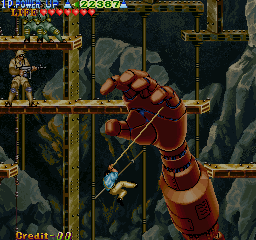
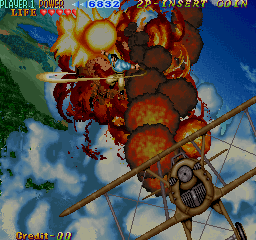
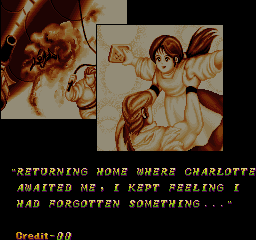
That actually brings me to my conclusion, setting me up to loop back around to that 2004 roundtable interview because there's one particular section I haven't highlighted yet that really speaks volumes about this game. When reminiscing about the challenge the game provided in its actual development, one of the interviewees said, "I got the strong impression that everyone working on Edward Randy had a really great time, though. They've told me "Edward Randy was the most fun I had of all the games I made at Data East'". That says a lot, right? That's somewhat tempered by the mentions of sleeping in the office and early morning drinking parties, but all the same, Edward Randy is a game that the developers had a whale of a time putting together, resulting in a cacophonous arcade action title that just does whatever the hell it wants with scenes packed to the rafters full of enemies and non-stop action from start to finish, and I respect that. I'm certainly going a little easy on the game compared to some games I've taken to task, but honestly, I think the main thing I would alter- not outright change- is the health system, specifically keeping the power-up and power-down element of it but just make it easier to tell when you're in grave danger and when you're good for some more hits, the see-sawing of your health is something I quite like even if it probably needed a bit of fine-tuning. Everything else? Keep it the way it is. It's a little awkward and somewhat overwhelming, but that's the kind of Data East madness I signed up for, and I wouldn't have it any other way. I just have a big soft spot for silly, over-the-top games like this, and Edward Randy is just an all-timer in this regard. You'll let me have this one, right, a little biased article, as a treat? I knew you would, ta!
For being a real Data East game, The Cliffhanger - Edward Randy is awarded...

In a sentence, The Cliffhanger - Edward Randy...
Was never gonna get an unbiased article by me, let's be real.
And now, it's that time, folks!
EXTENDED PLAY!
First up, revisional differences!
(The differences with world ver. 3 were found out by my own testing years ago but the rest here are from The Cutting Room Floor, look there for more!)
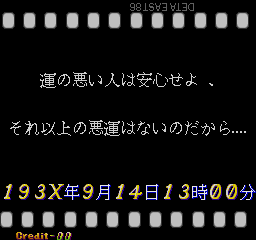
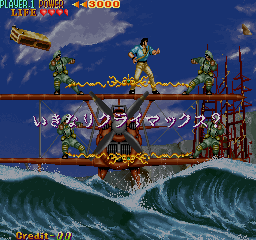
There's currently four versions of the game supported in MAME- one Japanese version labelled ver. 3 and three World versions labelled ver. 1, 2 and 3. The Japanese version has its cutscenes in Japanese of course, but also has titles for each stage and an interstitial scene after the game starts, omitted from every World version (translated on The Cutting Room Floor's page) plus it gives a date for the events of the game as September 14th whereas the English versions only give the year 193X (although the date can be seen in the cutscene before the start of Stage 3, showing the calendar). Otherwise, World ver. 1 and 2 are the same as Japanese ver. 3 aside from a minor spelling correction (the filmstrip in the Presented by Data East screen and credits sequence has 'Deta East' in Japanese ver. 3 and World ver. 1, a typo fixed for World ver. 2 and 3).
However, World ver. 3 has the biggest differences, primarily in the stage order. As mentioned, most versions start at the near-end of the story, with Edward having the second fight with the giant robot and stopping just as Dark Ogre appears for the final battle. It then cuts back to earlier that day and how Edward got into this mess starting with the boat stage, eventually catching up with itself up to the first fight with the giant robot, skipping ahead to the fight with Dark Ogre once it does. These are interspersed with cutscenes explaining the story to help players keep up, and these are translated into English for World vers. 1 and 2. World ver. 3, however, tells the story in a strictly chronological order, starting from the boat chase sequence and moving the two stages that fit between the first giant robot fight and the final boss nearer the end of the game. It also removes every cutscene in the game except the story sequence in the attract mode and the ending, perhaps to speed things up and reduce the amount of time people spent on the cabinet, but this has the side effect of the ending not making as much sense as it includes a surprise appearance from Jennifer, who was only introduced in one of the scenes cut from this version. Whoops!
Next, home ports, or lack thereof.
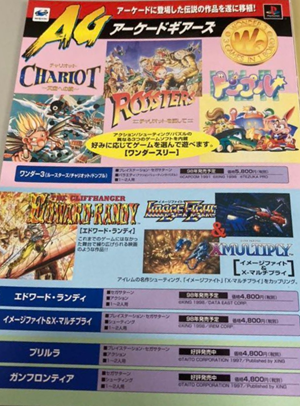
Given the sheer amount of stuff happening in this game, it's no surprise that there were no ports of this game for the Mega Drive or SNES, they just wouldn't be able to do the game justice. Stil, there was at least one planned port for the Sega Saturn as part of XING's Arcade Gears line of arcade game ports (the ones that did get released were Taito's Gun Frontier and Pu.Li.Ru.La, Capcom's Three Wonders and a combo-pack of Irem's Image Fight and X-Multiply). This was actually advertised in multiple XING promotional pamphlets- as pointed out by ohfivepro on Twitter it was shown in a 1997 pamphlet, then later appeared in a 1998 promo, pictured above with the shot taken from this auction listing. No real screenshots or details are shown in either of these pamphlets but it was planned for a 1997 release on Saturn, then delayed to 1998, then it just never happened.
Oh, there was also versions planned for Atari ST, Amiga and C64 by Elite but, according to Games That Weren't, nothing beyond maybe an early prototype was started. Phew.
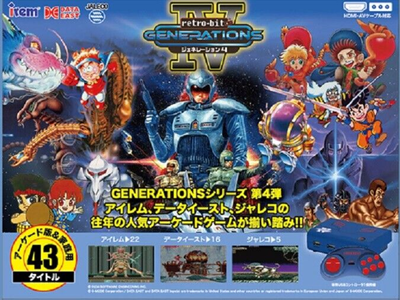
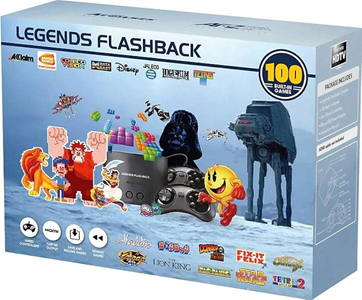
If you absolutely, positvely have to have some kind of port of Edward Randy short of getting an original PCB and the required tech to play it, then there's technically a few options! They're not very good options, but they definitely exist. First, the Retro-Bit Generations IV plug-and-play console released in 2018, as listed on MobyGames and with the boxart taken from this eBay auction, was a seemingly Japan-only version of the Retro-Bit Generations consoles that included Edward Randy. This is the only version of the Generations consoles that this game appears on it seems, and from what I've heard the Generations consoles are notorious for having lousy emulation including constant framerate dips and poor sound quality. Similarly, as pointed out by GDRI on Twitter, most versions of the AtGames Legends Flashback plug-and-play consoles include Edwaard Randy as well, and also have really bad emulation with similar framerate drops. Look, I love all my readers dearly but I am not, repeat, not spending out of pocket to get one of these piece of junk consoles sent to my house just to say, "Oh, yeah, that's not very good, is it" and then never think about it again. I hope you understand.
There's also a couple of connections with this game to other developers, especially M2 and Treasure.
An interview with Sega's Yosuke Okunari and M2's Naoki Horii about the 3D Classics line (specifically 3D Space Harrier here) goes into the history of M2 and their collaborative work with Sega. After impressing with their Mega Drive conversion of Gauntlet, Hiroshi Aso from Sega approached them and asked if they wanted to port any games to the Game Gear. M2 suggested Edward Randy as a potential candidate, but decided on Gunstar Heroes instead as in Naoki Horii's words, "If you think about it, Gunstar Heroes is just an improved version of Edward Randy". I mean, they're not really wrong...
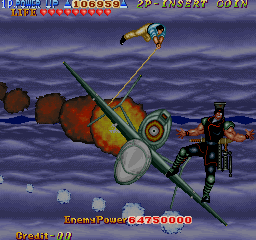
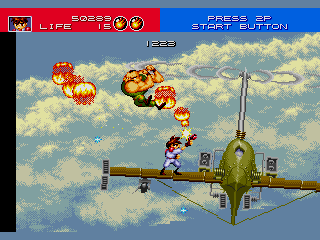
In particular, a boss fight seen in Edward Randy is very similar to one in Gunstar Heroes. Edward Randy's final boss, Dark Ogre, is fought on top of a constantly-moving plane where you fight one muscle-bound guy as the plane constantly moves and spins. The boss fight with Orange in Gunstar Heroes is very similar, although in this case the plane is actually properly scaling and rotating. Additionally, boss fights in Edward Randy have numerical values to represent their health which is exactly how Gunstar Heroes does it too, albeit with lower numbers. Also, as pointed out by MrTako, the 3DS version of Gunstar Heroes, also by M2, contains a cute nod to Edward Randy in its end credits (at 1:20), with Gunstar Red using the whip swing to beat Orange the old-fashioned way.
One of Treasure's later games would also include a cute little nod to the game too. One of the playable characters in Guardian Heroes is called Randy M. Green, and in the Japanese version of Guardian Heroes, as shown in this scan of Sega Saturn Magazine Books: Guardian Heroes, Randy's little rabbit-thingy buddy is called Edward M. Cognac. Put the two first names together and you get Randy Edward! Or, rather, Edward Randy, I imagine Randy Edward is the name of an obscure ZX Spectrum platformer. This little homage was lost in the International versions, as the rabbit-thingy was renamed Nando. I did try and confirm if this was actually intentional or just a weird coincidence, and I got half of an answer! The Japanese Wikipedia page for Edward Randy mentions that a particular dōjinshi by Treasure artist Tetsuhiko Kikuchi / HAN titled 素描帳 or Sobyō-chō specifically mentions Edward Randy as a big influence on his work, but unfortunately while some of his dōjin books have been scanned by GD_Cade and uploaded to archive.org, this particular one isn't one of them. So, we'll have to wait for a scan of it to show up to confirm it I'm afraid.
We're not done there, though! Edward Randy had a cameo in a completely different company's game! Kind-of!
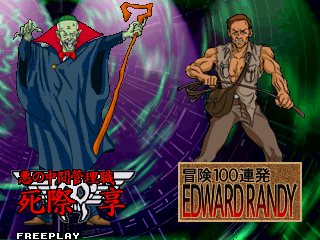
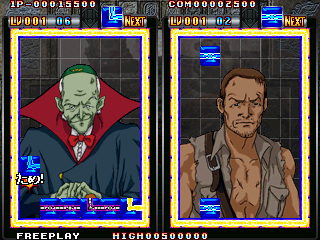
Hiroshi Nakamura, the game planner of Edward Randy, would later form a company called Kouyousha who you can find out more about on their GDRI page and in this interview with the man as linked on the Kusoge Wiki. They'd develop a few arcade games in the '90s that got published by Kaneko, and one of them was a puzzle game called Sen-Know released in 1999. Somehow, perhaps due to Nakamura's Data East connection, a much older Edward Randy- looking a little bit more like Harrison Ford, I mean only slightly- is included as an opponent, complete with the '100 Adventures' tagline!
Finally, I don't know where else to put this, so here's an archive of Data East's old website's page about Edward Randy.
Old websites are the best.
Oh, and here's the voice clips from the game in case you missed the link earlier.
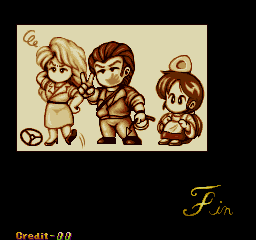
I hope to cover more Data East games in the future. Please look forward to it.
See, that ending line will never age, because I'll never have covered enough Data East games.



























